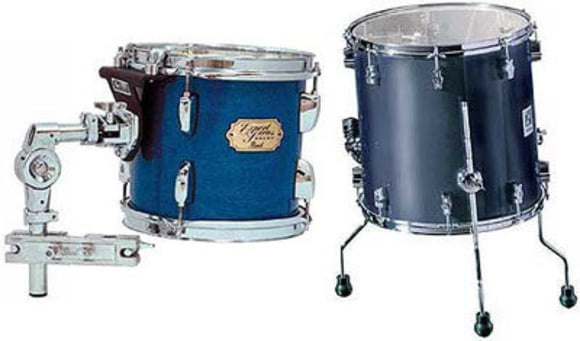3. Focus on Drum Shells
A modern drum set consists of various components. We distinguish three categories: drums/snare, hardware (stands, fittings) and cymbals.
This online guide mainly deals with drums. Before we take a closer look at details, such as the materials used in production and their characteristics, let's first of all get an overview over the most important instruments in a drum set.
The bass drum
It all begins with the bass drum, the foundation of every drum set! The bass drum delivers the solid, deep basic sounds which are the backbone, alongside the bass, of any proper groove, independent of which style of music you happen to be playing or listening to. The bass drum's size can vary widely (see also shell sizes and configuration). Jazz drummers often go for pieces which are barely larger than a floor tom. With rock music, sizes of 22 inches and upwards dominate.
Adjustable stands are placed on the sides of bass drums. They need to be rather sturdy because they have to both withstand the force of the kicks and bear the weight of the hanging toms. As a rule, you'll find a slot for a hanging tom mount - unless the drummer uses a tom rack, of course.

The bass drum with the drum pedal
As we have already mentioned, the bass drum is played with the foot. The movement of the foot is transferred to the beater via the pedal. Some pedals are constructed in truly outrageous ways. The beater can be replaced and is available in varying degrees of hardness.
The bass drum's batter head is sensibly placed facing the drummer, of course, on the same side where the pedal is screwed to the lowest part of the drum's rim. The side facing the audience is covered by the resonant head. Rock, funk and fusion drummers in particular often like to work with resonant heads which feature a circular opening. The batter head is simultaneously dampened by the use of a felt strip which is fastened between the shell and the rims of the drum. It is also customary to place some damping material, such as sponge rubber. But why do that, the thing is supposed to make some noise, isn't it?
Well, in it's unmodified form, that is, with a completely intact resonant head and entirely undampened, a bass drum can sound quite muddy, hollow, and therefore undistinguished. Properly placed damping can improve things, making the sound more controlled, directed and crisp, just as we know it from modern recordings. But you shouldn't just chuck any old damping material into your drum or cut a hole in it willy-nilly. You need to put in the effort to change your drum step by step to make it sound like you want it to sound. But beware: too much daping, and any bass drum will sound like a cardboard box!
Toms
And now, the toms (properly called tom-toms) They are not very different in shell construction from the bass drum, but are appropriately smaller. Toms are available in many different diameters and depths. These factors also affect their respective volume and sound (see also shell depth and diameter). Small-volume toms sound more akin to bongo drums, larger ones like shell drums.

A rack tom and a floor tom
Fundamentally, we distinguish flying toms and floor toms. Their names indicate where they are placed as part of the drum set. Flying toms are mounted on racks above the bass drum, and floor toms are placed next to the bass drum. The mounting racks necessary to mount the flying toms are available from all manufacturers, with each of them being convinced their own solution beats all others. The most important point is that the rack must be sturdy enough to withstand the constant pressure. Traditional floor toms have three feet which lend the usually larger (and especially deeper) tom shells a sure footing.
The snare
The snare drum, also known as the side drum, was given its name because it differs from the other shells in size. The snare's diameter may be larger than that of the tom, but its shell is quite low. Another difference is that a rattle of metal wires (snares) can be engaged inside the resonant head using a strainer. When the drummer hits the batter head, the resonant head opposite reacts and stimulates the snares. Depending on how tense the snares are, the rattle can be short and snappy or long and washed-out. Thanks to the snare, drum rolls sound more subtle on this drum so that more delicate drum work can be produced than on toms.

The snare drum is the most important drum in the set
These special features, in combination with its position within the set (right up front) make the snare the nerve centre of any groove, so to speak. The sound of a beaten snare pierces through the general sound of the band – it is like a signal.





